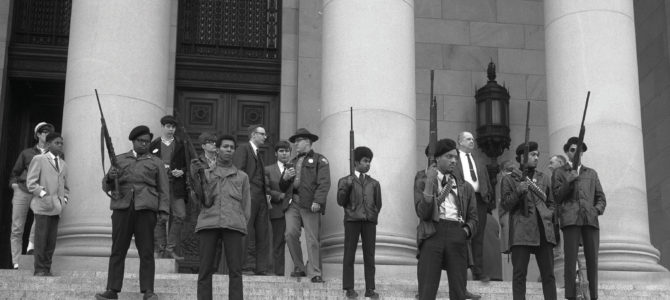
When I walked into the library of my university mid-semester and spotted a massive Black Panther Party tribute exhibit, it felt like a line had been crossed.
When my generation thinks of the 1960s, we think of milkshakes and poodle skirts. The civil rights movement, the war on crime, and World War II are reserved for pages in a textbook. The only thing that was truly passed down from my elders in that time period to me was a feeling of fear at two names: the Klu Klux Klan and the Black Panthers. They were radical organizations made up of thugs who sowed violence and inspired terror. Both managed to survive at least two generations.
Apparently, the Black Panthers’ reputation has been rehabilitated. The exhibit took up an entire room in the front entrance of the university library, and had a pristine, museum-grade quality rarely seen in the type of place that makes you pay for your own printer paper. It was made up of black and white photos of elders whose only significant action was to smile harmlessly at the camera.
Hosted, rather ironically, by the school’s Center for Judaic, Holocaust, and Peace Studies, the photos, according to the front board, “reveal the humanity of the groups’ members rather than their invented personae.” Black Panther members “are real people, with real stories, who are your next door neighbors. They don’t fit the profile of rabid, anti-white, cop-hating terrorists…”
Ericka Huggins is one of the smiling old ladies in the exhibit. She helped torture young Alex Rackley with other Black Panther members, boiling the water they used to pour over his chest and commanding him to be quiet when he pleaded for mercy. Now she’s a lecturing professor. Rackley is dead. After falsely admitting he was an informant in hopes of stopping the hours of torture, Black Panthers killed him and dumped his body in a river.
The exhibit is just one piece of a new attempt to rewrite the narrative of the Black Panthers and recast them as absolutely harmless. New articles and documentaries––and now a Golden Globe Awards joke––create a completely different organization who built free breakfast programs for children and medical clinics.
Never mind the fact that medical volunteers were forced to take classes on the Black Panther philosophy, that their socialist policy of giving away free supplies to supporters came from extortion of local businesses, or that the Black Panthers were literally building a militia of armed individuals who believed they were their own sovereign people surrounded by an oppressive nation of “whities” who deserved death.
Black Panthers Weren’t Helping Black Americans
It is sacrilegious to refer to Black Panther Party members as “misunderstood” when there were many other and better activists working to improve conditions of blacks at the time. Desegregationists of both races conducted sit-ins, effectively boycotted transportation, demanded legislation, and tested Supreme Court decisions. They won the Brown v. Board of Education decision, the Civil Rights Act of 1957, the Civil Rights Act of 1964, and the support of the president. Gaps between black and whites began closing.
In the midst of this, an undercurrent of tension and hate was taken advantage of by white and black supremacy groups that encouraged war. They fed off race riots and, when the violence they bred was reflected back at them, cried foul. They widened the gap between segregationists and desegregationists. The turmoil that kept the Black Panther Party alive eventually led to their implosion, as they began losing support and top members to jail and shootouts. They left little behind.
Extremism in an age of tension yields a vicious cycle of discord. The ‘60s are a strong example of this. The race riots that broke out in cities across America permanently crippled local economies, leading to a 4 to 7 percent decrease in male employment that lasted two decades wherever a riot had occurred. A 1968 New York Times article written by a concerned citizen pleaded with proponents of extremism, asking how they expected to accomplish change when the demands they made seemed to repel it.
“That expectations rise is good; that they rise so fast that no policy of any type carried out by anybody can satisfy them is bad. That people feel powerful and free to express their resentment is good; that their resentment may overthrow a system capable of satisfying their needs and hopes is bad.”
A Resurgence Of Extremism
This extremism has emerged today in ideologies that demand “reparations” barely disguised as a self-centered vengeance and are not interested in change, but commotion. Extremism is easy. It grants a satisfying self-righteousness to those who point fingers like a witch hunt at others. It doesn’t require tackling a problem or formulating the complicated solutions those problems demand.
If we look back to the 1960s and the parallel problems they faced––race riots, police brutality, black power, resurgences of socialism, protest on college campuses, and a divided America––history tells us that extremism doesn’t accomplish the real change that our nation so badly needs, but only adds to its wounds.
It is bad enough to be ignorant of history, but to misrepresent it is a crime of deception. Eliminating the bloody history of the Black Panther Party presents a fictional fairytale that defangs the past and hides all its traps. My generation deserves better than to be deceived by obsessive fans of an extremist organization that belongs in the past. We deserve better than simply replicating an older generation. And if we follow this path of extremism and discord, then we must be prepared for all of the consequences that come with it.









